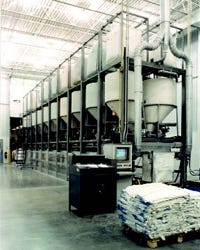Gain-in-Weight vs. Loss-in-Weight Batching Systems
January 14, 2010
Scott Culshaw
When determining whether a gain-in-weight or loss-in-weight system is best for your applications, the first step, I believe, is to recognize that this is a complex decision with roughly a dozen factors to consider—and each of these factors impact all the others. It is one of the most complex determinations involved with spec’ing a batching system.
|
A gain-in-weight system |
That said, the first step is to clarify priorities. Gain-in-weight is slower, but more accurate, since you are weighing only the amount discharged and only one product at a time on each scale. Loss-in-weight is faster, since you can discharge all the products at the same time, but it is less accurate.
Loss-in-weight allows you to discharge several ingredients simultaneously, but you need to monitor the weight of the discharging vessel. Most scales have a range of 10,000 increments that must cover the total material to be weighed. Thus, a 10,000-lb holding vessel can be weighed out in loss-in-weight mode in ±1 lb readout. If your discharge requires ±0.1 lb accuracy, of course, that option is not workable.
Other considerations include location, size of batch, time of batch, type of material, vibration in the area, sanitation requirements, clean-out, and cost. Finally, whether you are building a new facility, or retrofitting a plant that is running at full capacity has some bearing on which choice will best serve your needs. Let me offer a few thoughts on a few of these considerations.
If batches are small, you are likely more concerned with accuracy, so gain-in-weight is preferable. Regarding the type of material, if it is pharmaceutical grade, accuracy is critical, so again, gain-in-weight is the better option.
Is there vibration in the area? There are more load cells in a loss-in-weight system, and just one set in a gain-in-weight system. So, if there is vibration—a common condition—loss-in-weight may be preferable, all else being equal. Of course, the higher the batch weight, the less important vibration becomes.
Regarding sanitation, if you have to disassemble equipment for cleaning, as is the case with pharma and food products, gain-in-weight systems are much easier to manage.
Is the number of ingredients you are batching always the same? If batches are small and the recipe changes, you need to strike a balance between accuracy and speed. Two or three ingredients in a 4000-lb recipe? That’s a situation ideal for loss-in-weight, unless accuracy requirements are extreme. Need high accuracy? Gain-in-weight will produce a better result. Need high production speeds? Loss-in-weight will almost always be the better choice, but there can be a balance between the two types of systems.
The new vs. existing facility question primarily relates to available space, and whether the material will originate in paper bags, silos, or bulk bags.
To summarize, gain-in-weight is more accurate and more controllable than loss-in-weight, just a little slower, although you can accelerate production speed by producing multiple batches simultaneously, even when recipes differ. If you have the luxury of flexibility—if you’re building a new plant, for instance—this can be an incredibly efficient option.
Scott Culshaw is president and founder of Ingredient Masters (Cincinnati, OH), which provides custom-engineered solutions for dry ingredient handling and processing. For more information, e-mail [email protected] or visit www.ingredientmasters.com.
You May Also Like



